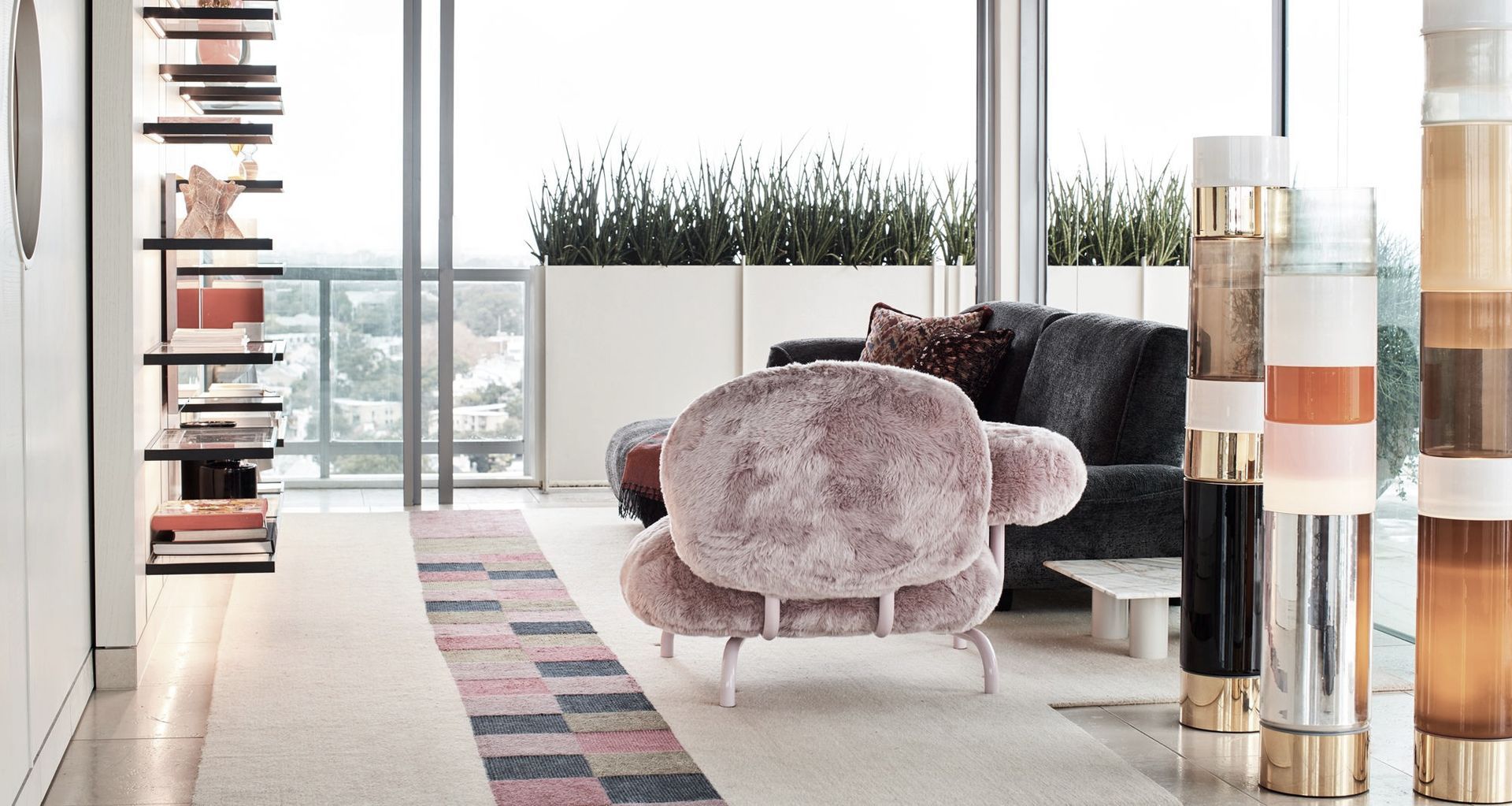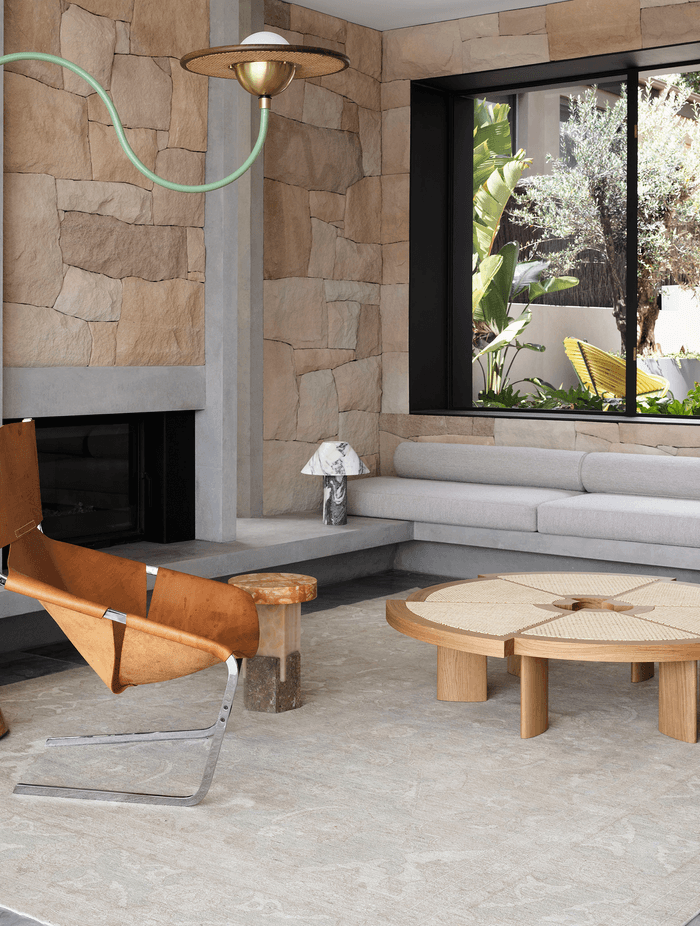The ultimate buyer’s guide to rugs
Written by
23 August 2022
•
8 min read

Purchasing a new rug requires more consideration than colour and size. The style and shape of the room in which it is intended to lay, how busy that room is and whether or not you have children or pets should all be given careful thought when evaluating the suitability of a new floor covering. We asked six Australian rug experts to provide their insights and guidance on how to choose the right rug for your home, the current trends, and how to identify the hallmarks of high quality floor coverings.
What are the best colours and patterns for rugs?
“There are a few colours that we find to be timeless and always popular. Blue and beige rugs are a classic choice here in Australia, possibly because of our airy coastal homes. A pattern that never goes out of style is a tiled or geometric-style pattern – they’re simple but impactful,” says Yosi Tal, managing director at Designer Rugs.
Jared Cadry, the creative director at Cadrys Rugs, concurs, and says that neutral hues are consistent favourites. “These are closely followed by shades of grey, blue, red and green,” says Jared.
“Deep rich tones or extremely light and neutral shades of beige and blush are trending right now,” says Jared, whose observation is shared by Yosi. “Pinks and golden brown hues are big sellers, and sometimes in combination with one another,” says Yosi. “Checkerboard patterns are also trending right now, and I think this trend will have staying power due to its simplicity and versatility.”
How do I choose a statement rug?
“Look for something that delights and inspires you! If you invest in a high quality rug it will be in your home for a long time, so you want it to bring you a little spark of joy whenever you see it. Rugs also take up a lot of visual real estate in a room, so you want to make sure it’s a style and colour that really speaks to you and your taste,” says Yosi. Jared takes a similar view, suggesting that homeowners should treat a rug like a piece of art for your floor. “Buy one that you fall in love with,” says Jared. “Opting for a slightly eclectic look in your home is a good thing, and a rug is a great way to add colour and flair to an interior.”
What size rug is right for my room?
“The size of your rug is determined by the architecture of the room it’s to go in,” says Luke Jones of Jenny Jones Rugs. “A rug defines a space and shapes the area in which it resides. My tip is to always allow at least 15-20cm of flooring around the border of the rug so it acts as a frame, don’t use a rug as wall-to-wall carpet. The bigger the rug, the better, as it’ll make the room feel larger and give you more room to play or decorate with, as it will frame the story of the room.”
Lily Ng, product consultant at Bremworth Carpets and Rugs, says rug size is guided by furniture. “My preference is to have furniture on the rug – or at least partly on – which usually requires a larger rug, plus it’ll make the space look bigger,” says Lily. “For a dining room, use your table size as a guide. You want the rug to be big enough to accommodate a pushed-back chair.” If it’s an open plan space, Lily suggests using a larger rug that comfortably fits all the furniture of the ‘zone’ you want to define, such as a living zone in an open-plan kitchen, living and dining area. Lily’s top tip? “Outline the space with a piece of string before committing.”
Related article: How to choose the right size rug for your dining table
What is the best rug shape?
When it comes to choosing the shape of your rug, Luke suggests allowing your architecture to guide your decision. “If you have an entrance with a staircase and circular room, I would choose a circular rug so it connects with – and complements – those curves. If the same room were a rectangle space instead, I would opt for a corresponding rug to marry it all together with lines,” says Luke. Lily suggests that round rugs look fabulous in entry foyers that are more square than rectangular. “I would usually opt for a rectangular rug, but I really like circular rugs for children’s rooms,” she adds.
Luke says that while rectangles and circles are generally the classic shapes as they suit most homes, statement rugs in odd shapes, such as a star, half-circle or half-square, break up the usual lines.
What are the best fibres for rugs?
“I always recommend natural fibres, which at Bremworth Carpet and Rugs, would be wool – nature's miracle fibre! There are other natural fibres on the market such as jute, sisal and cotton, but you really can't beat wool for all its natural qualities.” says Lily. “Inside the home, I think you can't go wrong with wool as it’s so durable and has so many desirable properties.” Wool is considered to be naturally resistant to dust mites and allergens, dirt repellent and soft underfoot. “Rugs for outdoor areas will need to withstand the elements, and this is the only situation you would choose a plastic fibre, perhaps a recycled PET (polyethylene terephthalate) rug.” adds Lily.
Should I opt for a low or high pile rug?
Some rugs have a thick pile you can sink your toes into, while others are soft and almost smooth, but how do you know which is best for your situation? “I wouldn't recommend a long or high pile rug for a dining area or busy high traffic areas as dirt gets trapped in a high pile more easily than in a short pile,” says Lily. “However, shag piles are predicted to come back in fashion, like many styles from the ‘70s.”
How do I identify a high quality rug?
The hallmarks of a high or low quality rug will vary depending on whether it is hand tufted or woven. “The clues to spotting a high quality woven rug are on the back: machine made rugs will be almost ‘too perfect’ and have telltale signs such as fringing that is sewn on, rather than a part of the rug itself. High quality knotted rugs will have fine detail, and you’ll be able to see the slight imperfections of human hands,” says Lia Pielli, senior designer at Designer Rugs.
“For hand-tufted rugs, the backing is often covered with latex or canvas so a good thing to look for is quality materials. New Zealand wool is considered one of the highest quality wools in the world, so look for this on your rug label! Also look out for even dying, dense pile and clean and tidy linework. Tufted rugs can come in varying qualities, so often the old mantra ‘you get what you pay for’ is a good rule of thumb.”
How do I choose an ethical and sustainable leather or cowhide rug?
Leather and animal hide rugs need to meet a different set of criteria to that of your usual floor covering. Ramon Cassel, the founder of Bagé Home, says shoppers should check the credentials of leather and animal hide rug suppliers for sustainable and ethical certifications of production and procurement. “Good practices should reflect not only in the product itself, but also in the way the company manages packaging, waste and other environmental and social practices,” says Ramon.
“Cowhide rugs vary in quality and are rated from A to C grade, depending on the tanning process, product sourcing and craftsmanship, plus the patches and colours,” says Ramon. “A high quality rug should be soft, floppy and easy to fold with an even thickness. Stiff cowhides with wrinkles that last after unfolding, edges that curl or shedding are lower quality.”
How much does a decent rug cost?
The price of your rug depends entirely upon the size and quality of its construction. Some smaller area rugs may only set you back a couple hundred dollars, but these are usually mass manufactured from low-quality synthetics and aren’t intended to last beyond a few seasons. A mid-range rug will run into the very early thousands and provide you with more complex shape, size, fibre and colour options, while you can expect a custom or designer rug to run well north of that.
Shop from a range of gorgeous rugs on ArchiPro now.








